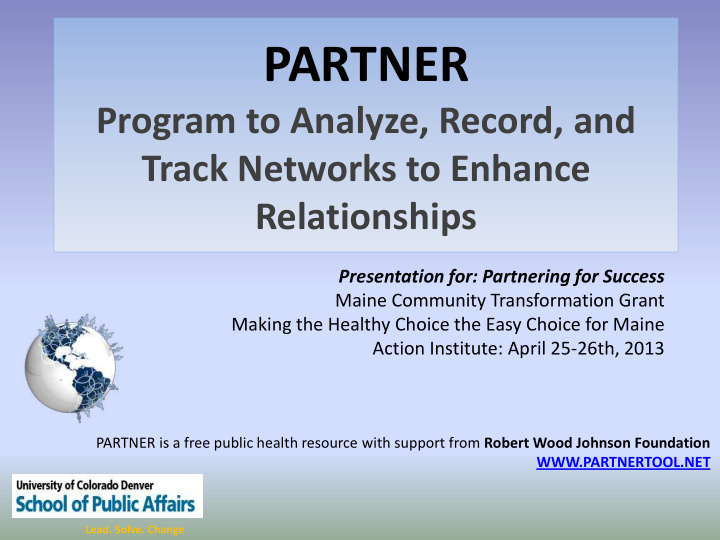



PARTNER Program to Analyze, Record, and Track Networks to Enhance Relationships Presentation for: Partnering for Success Maine Community Transformation Grant Making the Healthy Choice the Easy Choice for Maine Action Institute: April 25-26th, 2013 PARTNER is a free public health resource with support from Robert Wood Johnson Foundation WWW.PARTNERTOOL.NET Lead. Solve. Change
Goals for Today’s Session Provide a conceptual foundation for thinking about collaboration in a network framework Introduce PARTNER: Program to Analyze, Record, and Track Networks to Enhance Relationships www.partnertool.net Uses social network analysis methods Collects network data on community collaborative initiatives Used by public health practitioners to evaluate partnerships
The Public Health Paradigm Shift Graphic from NACCHO (MAPP website): http://www.naccho.org/topics/infrastructure/MAPP/index.cfm
The Public Health Paradigm Shift Graphic from NACCHO (MAPP website): http://www.naccho.org/topics/infrastructure/MAPP/index.cfm
Working Across Boundaries is an Essential Public Health Function Transit HCP Employers Civic Groups Faith Instit. Law Enforcement EMS Mental Health Elected Parks and Rec Officials Dentists Tribal Health Public Health Drug Dept NGOs Treatment Labs Fire Corrections Home Health CHCs Neighborhood Orgs. Nursing Homes City Planners Schools Graphic from NACCHO (MAPP website): http://www.naccho.org/topics/infrastructure/MAPP/index.cfm
Why Do We Need New Concepts & Tools? • Provide an additional way to evaluate partnerships. • Current Assumption = More is better. – More partners = successful collaboration (counting noses) • Alternative Assumption = Less can be more. – Not based on how many partners you have, but how they are connected. New Relationship YOU YOU YOU
Start Thinking Like a Network Scientist
Social Network Analysis Social Network Analysis (SNA) is a method to gather and analyze data to explain the degree to which network actors connect to one another and the structural makeup of collaborative relationships (Scott, 1991).
Elements of SNA • Collects data on who is connected to whom • How those connections vary and change • Focus on patterns of relations • Distinct from the methods of traditional statistics and data analysis…theories, models, and applications are expressed in terms of relational concepts or processes .
Elements of a Network: Nodes Set of actors (nodes) connected by a set of ties • Individuals • Organizations, departments, teams These nodes have attributes • Any description of the node • Often characterized by groups (e.g. gender, sector)
Elements of a Network: Ties Ties connect pairs of actors 1 • Directed (i.e., potentially 2 one-directional, as in giving 1 advice to someone) 3 3 • Undirected (as in being physically proximate) 1 2 1 • Dichotomous (present or 3 absent, as in whether two people are friends or not) or 2 • Valued (measured on a scale, as in strength of friendship)
PARTNER PROGRAM TO ANALYZE, RECORD, AND TRACK NETWORKS TO ENHANCE RELATIONSHIPS • Survey • Analysis Tool • Technical Guide • Web Demos www.partnertool.net
Benefits to Using PARTNER PARTNER is unique from other social network analysis tools because comprehensive set of tools includes both a survey and an analysis tool. The survey is linked to the analysis tool, allowing you to analyze your data with a simple command to “upload” your data. With PARTNER , you can: 1. Evaluate how well your collaborative is working in terms of identifying the "right" partners, leveraging resources, and strategizing for how to improve the work of the collaborative. 2. Demonstrate to partners, stakeholders, evaluators, and funders how your collaborative is progressing over time and why working together is making tangible change. 3. Engage in strategic collaborative management to develop action steps and implement change to reap the benefits of social networking.
Using SNA for Quality Improvement • Network data tell us about how people/organizations are connected including the quantity and quality of those connections. – Alone = hard to interpret or use in practice • Instead = Strategic Network Management (CQI process) – Identifying the ideal network – Measuring the Network – Identifying the gap between the actual and ideal network – Creating action steps to get closer to the idea.
Who Uses PARTNER? Users in the United States
Who Uses PARTNER? Users Around the World
How It Works Members of the Collaborative Answer Surveys One Person Collects Surveys and Uses PARTNER to Analyze Data
Follow These 4 Steps
PARTNER Step 1 The Respondents – Identify the members of the collaborative to evaluate – Enter respondent information People who represent members of a coalition or partnership Organizations or Individuals
Recommend
More recommend